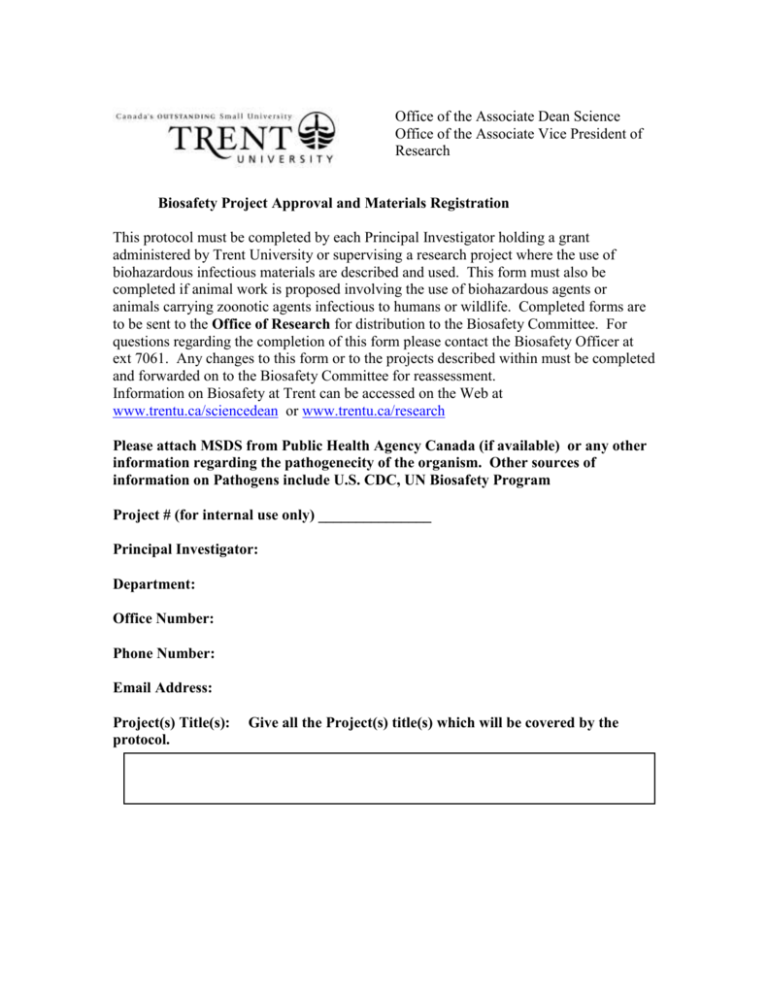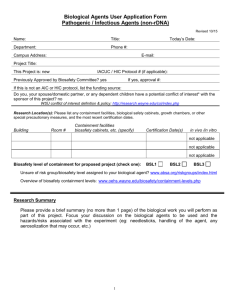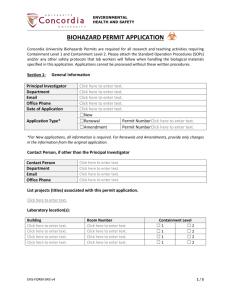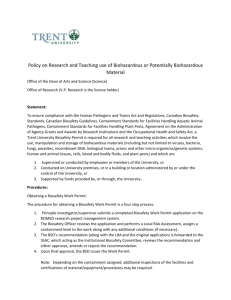Office of the Associate Dean Science Office of the Associate Vice
advertisement

Office of the Associate Dean Science Office of the Associate Vice President of Research Biosafety Project Approval and Materials Registration This protocol must be completed by each Principal Investigator holding a grant administered by Trent University or supervising a research project where the use of biohazardous infectious materials are described and used. This form must also be completed if animal work is proposed involving the use of biohazardous agents or animals carrying zoonotic agents infectious to humans or wildlife. Completed forms are to be sent to the Office of Research for distribution to the Biosafety Committee. For questions regarding the completion of this form please contact the Biosafety Officer at ext 7061. Any changes to this form or to the projects described within must be completed and forwarded on to the Biosafety Committee for reassessment. Information on Biosafety at Trent can be accessed on the Web at www.trentu.ca/sciencedean or www.trentu.ca/research Please attach MSDS from Public Health Agency Canada (if available) or any other information regarding the pathogenecity of the organism. Other sources of information on Pathogens include U.S. CDC, UN Biosafety Program Project # (for internal use only) _______________ Principal Investigator: Department: Office Number: Phone Number: Email Address: Project(s) Title(s): protocol. Give all the Project(s) title(s) which will be covered by the Lay Summary(s): Give a separate lay summary for each project included in this Protocol. List each pathogen in each project. Location where experimental work to be carried out: Building Room(s) **For work being performed at affiliated institutions or away from Symons Campus please indicate full address. If the affiliated institution has a safety officer, their signature of approval will be required prior to review by the Biosafety Committee review** Funding Agency/Agencies: Names of all personnel working under the Principal Investigator in the location listed above. 1. 3. 5. 2. 4. 6. Note: All personnel (students and staff) who will be working with Biohazardous material rated as risk group 2 or above are required to take the Biosafety course. Contact the Biosafety Officer or Science Facilities Manager (ext. 7061) for course information. Methods: (Describe in detail the methods you will be using in the proposed project. Attach additional pages if necessary). 1.0 Microorganisms Does your work involve the use of microorganisms? If not proceed to 2. Yes No Is this for active work; Yes No Or is this for a storage permit Yes No (Note: All substances considered as biohazardous risk group 2 or greater must be permitted and an inventory maintained, even if no experimental work is on-going). Please complete the table below: Name of Is the Microorganism microorganism (Family/genus/sp. known to be a e.g., Pox human viridae/Vaccinia) pathogen? Yes/No (if yes give name of disease) Is the microrganism known to be an animal pathogen? Is the microorganism known to be a zoonotic agent? Yes/No (if yes give name of disease) Yes/No (if yes explain the risk) Risk Group (1,2,or 3) Maximum quantity to be cultured or in possession at any one time? Yes/No For each substance listed above what is the source of the microorganism? 1 2 3 4 5 6 2.0 Cell Culture Does your work involve the use of cell cultures? If no proceed to 3. Please complete the table below: Cell Type Name of Cell Line Yes Is this cell type used in work? Yes/No Human Rodent Other * derived from fresh tissue For each cell line list the supplier of primary cell culture tissue? No Established or Primary* (print one) For each cell types give the HC or CFIA risk group (1 2 3). 3.0 Use of Human Source Materials Does your work involve the use of human source materials? If no proceed to 4.0 Indicate if the following will be used in the lab. Human blood (whole) or other bodily fluids? If Yes please Specify: Yes No Yes No Human blood (fraction) or other bodily fluids? If Yes please specify: Yes No Human Organs (unpreserved) ? If Yes please specify: Yes No Human tissues (unpreserved) ? If yes please specify: Yes No Yes No Yes No Yes No Yes No Yes No Yes No 4.0 Genetically Modified Organisms and Cell lines Will genetic modifications be made to the organism or cell line? If no please proceed to 5.0 Will genetic sequences from the following be involved? Genes from any CDC class 1 pathogens If yes pleas specify: Other human or animal pathogen and/or their toxins If yes please specify: Will intact genetic sequences be used from: SV 40 Large T antigen If Yes please specify: Known oncogenes If Yes please specify: Will a live vector(s) (viral or bacterial) be used for gene transduction If Yes name vector: Will virus be replication defective Will virus be infectious to humans or animals Will this be expected to increase the Containment level required Yes Yes Yes No No No 5.0 Animal Experiments Will any of the agents listed be used in live animals Yes No Name of animal species to be used ACC protocol number (All experiments with vertebrate animals requires approval f the Animal Care Committee). If using murine cell lines, was the cell line tested for murine or mammalian pathogens. Yes No Yes No Yes No Yes No Yes No 6.0 Biological Toxins Will toxins of biological origin be used If no please proceed to 7.0 If yes, please name the toxin: What is the LD 50 of the toxin: 7.0 Import Requirements Will the agent(s) be imported (or were they imported originally prior to your acquisition)? If no proceed to 8.0 Has an Import permit been obtained from HC for human pathogens? Has an Import permit been obtained from CFIA and has a letter from HC indicating that an HC permit is not required, been obtained Has a copy of the permit been sent to the BSO Yes No Note: Importation requirements for human, animal and plant pathogens vary considerably contact the BSO for assistance in obtaining these permits. Persons receiving hazardous substances will require Transport Dangerous Goods training. Contact the Science Facilities Manager for details. All imports require the approval and signature of the BSO prior to acquisition. 8.0 Radioactive Material. Will Radioactive material be used. If yes please give the Radiation Permit #. Yes No If no proceed to 9.0. Note: Work with Radioactive substances at Trent University requires a Radiation Work Permit and that all personnel handling Radioactive Material have taken the Radiation Safety Course. Contact the RSO or the Science Facilities Manager at ext. 7061. 9.0 Training Requirements for Personnel named on Form All personnel named on the above form who will be using any of the above named agents are required to attend the following training course given by the Health and Safety cocoordinator and the BSO as a minimum. The use of animals or radioactive substances will require additional training. Contact the Environmental Health and Safety Officer or the Science Facilities Manager for additional information. Biosafety WHMIS As the principal investigator, I have ensured that all of the personnel named on the form who will be using any of the biohazardous agents in Sections 1-8 have been trained. Signature: Date: 9. Containment levels For the work described above please and based on your Hazard Risk Assesment circle the highest containment level required 1 2 3 Has the facility (Building and room number) been certified by the Biosafety Committee for this level of containment? Yes No 10. Methodology Attach the specific methodology you will use for your work. Include descriptions of techniques such as any method which may produce aerosols (i.e., vortexing, centrifuging, mixing of solutions). Include the specifics of your decontamination of instruments, equipment, waste products and sample destruction. 11. Principal Investigator Commitment I agree to conduct my research in accordance with all of the regulations and guidelines (Federal, Provincial and Institutional) which this project may fall under. I agree that all of the information above is accurate to the best of my knowledge and I agree not to change the project, with the exception of improving safety, without notifying and getting the approval of the Biosafety Committee first. Signature of Principal Researcher: Approvals Date: Trent Bio-safety Committee Chair, Bio-Safety Committee Signature:____________________________ Date:________________ V.P. Research and International Bio-Safety Officer Signature:_____________________________ Date:________________ Chris Williams Health & Safety Officer Signature:_____________________________ Date:________________ Bill Gibson External Safety Officer (if applicable Signature: Date:________________







